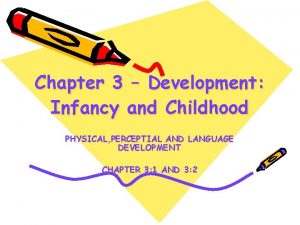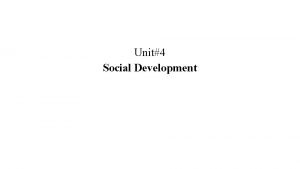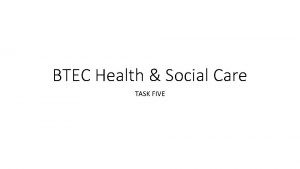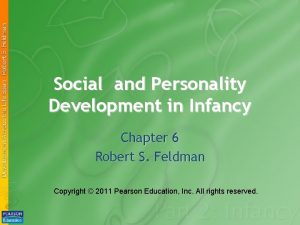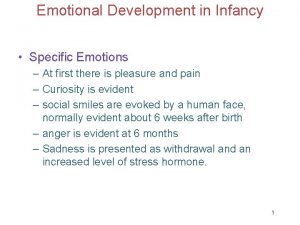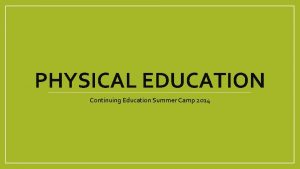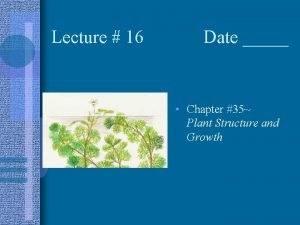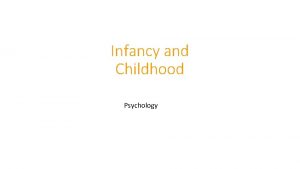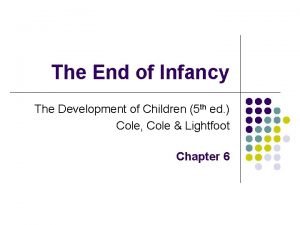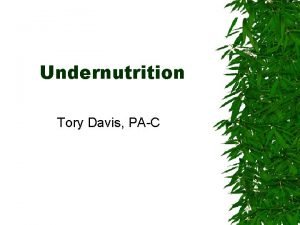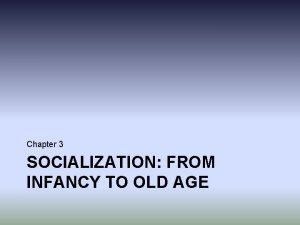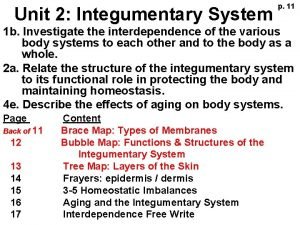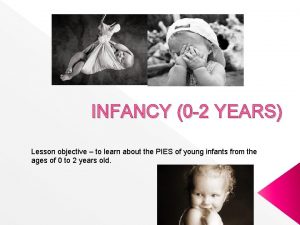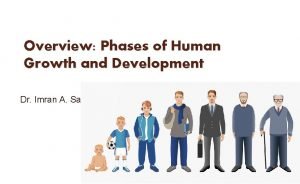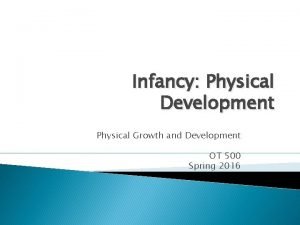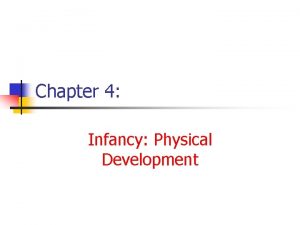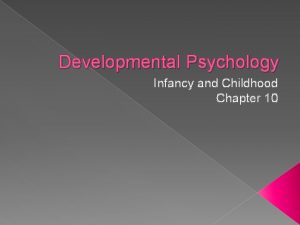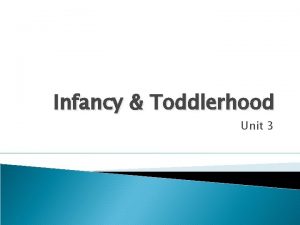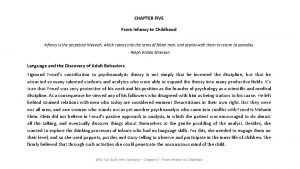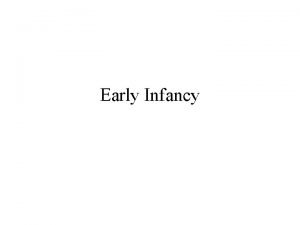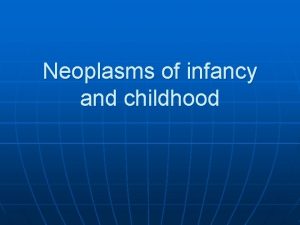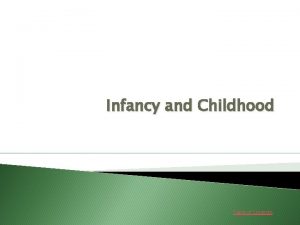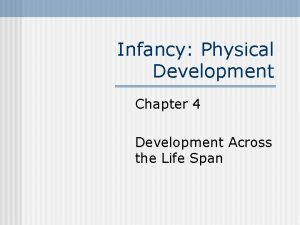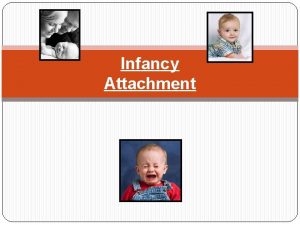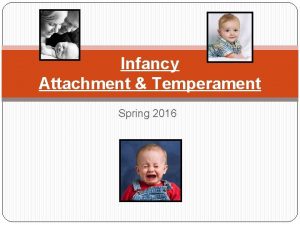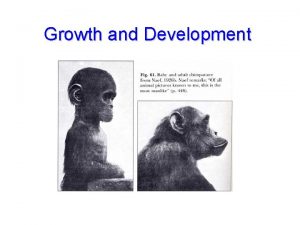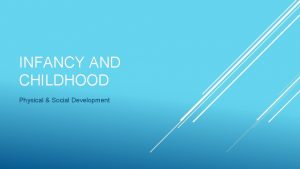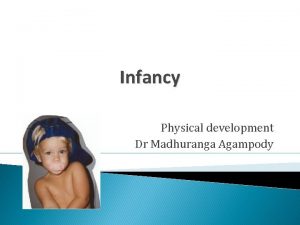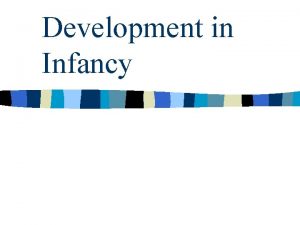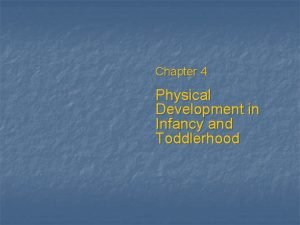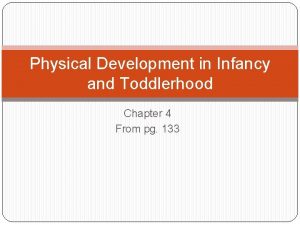CHAPTER 4 Infancy Physical Development Physical Growth and










































- Slides: 42

CHAPTER 4 Infancy: Physical Development

Physical Growth and Development

Sequences of Physical Development Cephalocaudal and Proximodistal • Cephalocaudal – Development proceeds from the upper part of the head to the lower parts of the body – Due to the importance of brain regulation such as breathing – Head develops more rapidly than the rest of the body during embryonic stage • Proximodistal – Development proceeds from the trunk outward – From body’s central axis toward the periphery – Brain and spinal cord follow a central axis down through body due to necessity for nerves to be in place before infant can control arms and legs

Differentiation • As children mature, physical reactions become – less global – more specific • Neonate’s response – to stimuli such as a burn may include thrashing about, crying, withdrawing the burned finger • Toddler’s response – may cry as well and withdraw finger, but thrashing about as a response to the pain is gone

Patterns in Height and Weight • Most dramatic gains in height and weight occur during prenatal development • Weight gains – 5 months – 1 st year – 2 nd year Double birth weight Triple weight Gain 4 to 7 pounds • Height gains – Infants grow in spurts and do not follow smooth growth chart – 1 st year Height increases by 50% – 2 nd year Grow 4 to 6 inches:

Fig. 4 -1, p. 73

Changes in Body Proportions • Head – Neonate head is about one-fourth the length of body – Gradually diminishes in proportion to the body – Doubles in size by adulthood • Arms and legs – – Equal in length in the neonate Arms grow more rapidly than the legs at first Arms grow longer than legs by 2 nd birthday Legs will soon catch up and surpass the arms • Neck lengthens by first birthday

Failure to Thrive (FTT) • Organic FTT (OFTT) – A biological underlying health problem accounts for infant’s failure to obtain or make use of adequate nutrition. – Does not make normal gains in weight • Nonorganic FTT (NOFTT) – A nonbiologically based underlying health problem accounts for the infant’s failure to obtain or make use of adequate nutrition. – Has psychological roots, social roots, or both – Does not make normal gains in weight

Failure to Thrive Problems • FTT infants typically have feeding problems. – Variable eaters – Less hungry • Slow physical growth • Cognitive, behavioral, and emotional problems

Catch-Up Growth • Organic factors – Illness and diet can slow child’s genetically determined growth pattern • If problem is addressed, – child’s rate of growth frequently accelerates to approximate its normal curve – Referred to as canalization

Nutrition: Fueling Development • Infant nutrition guidelines – From birth, should be fed breast milk or iron-fortified infant formula (first year or longer) AAP – Solids generally introduced 4 -6 months of age – Cow’s milk should be delayed until 9 -12 months of age – Avoid overfeeding or underfeeding – Provide some fat and cholesterol – Do not overdo high-fiber foods – Avoid added sugar and salt – Encourage eating of high-iron foods

Breast Feeding versus Bottle Feeding Past to present • Breast feeding has become more popular • 70% of American mothers now breast feed for some time Pros of breast milk • • Considered to be the best nourishment for infants Does not upset the infant’s stomach Is adequate nourishment for first 6 months after birth Conforms to human digestion processes & changes to help meet infant’s changing needs.

Breast Feeding versus Bottle Feeding (cont’d) Benefits for infant Benefits for mother • Improved immune system functioning • Reduces the risk of early breast and ovarian cancer • Protects against childhood lymphoma • Stronger bones and reduced likelihood of hip fractures that result from osteoporosis following menopause • Decreased likelihood of – developing allergic responses and constipation – developing obesity later in life – developing serious cases of diarrhea • Better neural and behavioral organization • Helps shrink uterus after delivery

Pros of Bottle Feeding • Allows for others to feed the infant • Breasts are not sore and tender • Mother is not sole provider for nourishment

Development of the Brain and Nervous System

Development of the Brain and Nervous System • People are born with 100 billion neurons. – Each neuron has a cell body, dendrites, and an axon – Dendrites • Short fibers that extend from cell body and receive incoming information – Axon • Extends trunk-like from the cell body and accounts for much of the difference in length in neurons – Neurotransmitters • Message-carrying chemicals released from axon terminals

Fig. 4 -2, p. 76

Myelin • Myelin sheath – Fatty, whitish substance that encases and insulates axons • Myelination – Process by which axons are coated with myelin – Not completed at birth – Myelination of brain’s prefrontal matter continues into the 2 nd decade of life • Multiple sclerosis – Myelin is replaced by hard, fibrous tissue that disrupts the timing of neural transmission, interfering with muscle control – PKU and congenital infection with HIV affect the myelination process

Structures of the Brain • Medulla – Vital in the control of basic functions such as heartbeat and respiration – Part of brain stem – Nerves that connect spinal cord to higher levels of the brain pass through here • Cerebellum – Helps child maintain balance, control motor behavior, and coordinate eye movements with bodily sensations • Cerebrum – Two hemispheres that become more wrinkled as child develops, coming to show ridges and valleys called fissures – Contributes to human learning, thought, memory, and language

Growth Spurts of the Brain • Formation of neurons completed at birth • First growth spurt – During 4 th and 5 th month of prenatal development – Due to formation of neurons • Second growth spurt – Between 25 th week of prenatal development and the end of the 2 nd year of life after birth – Due to proliferation of dendrites and axon terminals

Fig. 4 -3, p. 78

Brain Development in Infancy • Myelination contributes to what infants are able to do. • Reflexive functions such as breathing due to myelination • Myelination of motor pathways allows neonates to show stereotyped reflexes. • Myelination will allow the disorganized movements of the neonate to come under increasing control. – Myelination of motor area of the cerebral cortex begins at the 4 th month of prenatal development. – Myelination of the nerves to muscles is largely developed by the age of 2 years. – Some myelination continues to some degree into adolescence.

Brain Development in Infancy (cont’d) • Sensory development – Vision, hearing, and skin senses are less well myelinated at birth. – Myelination progresses and allows for increasingly complex and integrated sensorimotor activities. – Hearing • Myelination begins at 6 th month • Continues through age 4 – Vision • Myelination begins only shortly before full term • Completes process by 5 th or 6 th month

Nature and Nurture in Brain Development • Sensory stimulation and physical activity during early infancy sparks growth of the cortex. • Infants have more connections among neurons than adults. – Connections activated by experience survive – Others are pruned • Lack of stimulation – Can impair motor development and adaptability

Motor Development

Motor Development • Motor development follows cephalocaudal and proximodistal patterns and differentiation. • Neonates can lift head up aiding in avoiding suffocation. – First they lift head – Then they lift chest • Heads must be supported when held – Can hold up head between 3 to 6 months old

Fig. 4 -6, p. 81

Control of the Hands: Getting a Grip • 3 months – Infants make clumsy, swiped movements toward objects – Ulnar grasp • 4 to 6 months – Infants are more successful at grasping objects – Can transfer objects back and forth between hands. – Good age for giving rattles, large plastic spoons, mobiles, and other brightly colored hanging toys that are kept out of reach • 9 to 12 months – Pincer grasp gives infants ability to pick up tiny objects – Oppositional thumb comes into play • 15 to 24 months – Children show progression in stacking ability

Locomotion • 6 months – Infants roll over, turn from back to stomach – Infants can sit if supported • 7 months – Infants usually sit on their own • 8 to 9 months – Infants begin to crawl or creep – Standing overlaps with crawling and creeping – May walk with support of adult • 11 months – Infants can pull themselves up

Locomotion (cont’d) • 12 to 15 months – Walk on their own, earning the name of toddler – Run in bowlegged manner – Fall easily because they are top heavy • Some toddlers fall without notice and get back up • Others cry • Toddlers differentiate between shallow slopes and steep ones, choosing to slide or crawl down steep ones • Age 2 – Child can climb one step at a time, run well, walk backward, kick a large ball, and jump several inches

Locomotion (cont’d) • Myelination and differentiation of the motor areas of the cortex must occur to master skills • Neonate’s stepping and swimming reflexes – disappear when cortical development inhibits some functions of the lower brain – reappear later, yet differ in quality • Effects of training – Early introduction to extensive motor skills training levels off (Arnold Gesell study, 1929) • Iranian infants (unlike Hopi children) in orphanage were exposed to extreme social and physical deprivation – They did not overcome motoric retardation (Dennis study, 1960)

Sensory and Perceptual Development

Visual Acuity, Peripheral Vision, and Preference • Neonates – Extremely nearsighted at about 20/600 – Have poor peripheral vision • Expands to 45 degrees by the age of 7 weeks – Prefer stripes and curved lines – Prefer and identify mother’s face • After 8 hours of contact over 4 days – Prefer edges of face such as chin • May be due to attention to movement and contrast • Most dramatic gains in visual acuity made between birth and 6 months of age – Acuity reaches about 20/50 • By 3 to 5 years, – visual acuity generally approximates adult levels about 20/20

Fig. 4 -7, p. 83

Fig. 4 -8, p. 84

Depth Perception • Infants generally respond to depth cues by 6 to 8 months • Visual cliff study, Gibson and Walk (1960) – Identified age at which infants have depth perception – Ability to crawl indicated in ability to perceive depth • Campos et al. (1970) study – Heart rate increased when infants placed on edge of cliff at 9 months of age – Newly walking infants more afraid of falling off – Different postures involve the brain in different ways and influence infants’ avoidance (Adolph, 2000)

Fig. 4 -9, p. 85

Development of Perceptual Constancies • Perceptual constancy – Tendency to perceive an object to be the same even though the sensations produced by the object may differ under various conditions • Size constancy – Tendency to perceive the same objects as being the same size even though their retinal sizes vary as a function of their distance – Present in early infancy (Bower, 1974) • Shape constancy – Tendency to perceive that the shape of objects remains the same regardless of the retinal image being received – At 4 to 5 months old, infants grasp shape constancy under certain conditions.

Development of Hearing • 1 month – Infants perceive differences between speech sounds that are similar. – Infants exposed to normal backdrop of moderate noise levels become habituated to them and not likely to awaken unless there is a sharp, sudden noise. • 3 ½ months – Can discriminate parent’s voices • 18 months – Hearing is similar to adults’ • Exposure to native language causes gradual loss of capacity to discriminate sounds that are not in their native language

Development of Coordination of the Senses • Young infants recognize that objects experienced by one sense are the same as those experienced through another sense. • Five-month-old infants look at novel stimulation longer than familiar sources of stimulation. – Infants looked at unfamiliar objects longer than objects they had held in their hands. – This shows a transfer of information from the sense of touch to the sense of vision

The Active-Passive Controversy in Perceptual Development • Changes in perceptual processes of children develop from passive, mechanical reactors to the world into active, purposeful seekers and organizers of sensory information. • These changes include 1) intentional action replacing “capture” • automatic responses to stimulation 2) systematic search replacing unsystematic search 3) attention becoming selective 4) irrelevant information becoming ignored

The Role of Nature and Nurture Evidence for the role of nature • Neonates born with sensory skills and perceptual skills – can see nearby objects, hearing is fine, able to track moving objects, prefer certain kinds of stimuli • Sensory and motor changes linked to maturation of nervous system Evidence for the role of nurture • Children have critical periods in their perceptual development. – Failure to receive adequate sensory stimulation can result in permanent sensory deficits • Health problems with vision in child’s eye where patch is needed extensively can result in permanent visual impairment
 Social development in late childhood
Social development in late childhood Infancy and childhood physical development
Infancy and childhood physical development Module 46 infancy and childhood physical development
Module 46 infancy and childhood physical development Chapter 5 cognitive development in infancy and toddlerhood
Chapter 5 cognitive development in infancy and toddlerhood Social development in infancy and childhood
Social development in infancy and childhood Module 47 infancy and childhood cognitive development
Module 47 infancy and childhood cognitive development Intellectual development in health and social care
Intellectual development in health and social care Module 47 infancy and childhood cognitive development
Module 47 infancy and childhood cognitive development Socioemotional development in infancy
Socioemotional development in infancy Infancy psychosocial development
Infancy psychosocial development What are the stages of growth
What are the stages of growth Personality development in infancy
Personality development in infancy Personality development in infancy
Personality development in infancy Emotional development in infancy
Emotional development in infancy Infancy physical changes
Infancy physical changes Psychology chapter 10 infancy and childhood
Psychology chapter 10 infancy and childhood Chapter 10 infancy and childhood
Chapter 10 infancy and childhood Chapter 10 infancy and childhood review worksheet answers
Chapter 10 infancy and childhood review worksheet answers Summer camp 2014
Summer camp 2014 Chapter 35 plant structure growth and development
Chapter 35 plant structure growth and development Chapter 35 plant structure growth and development
Chapter 35 plant structure growth and development Infancy and childhood psychology
Infancy and childhood psychology Lesson quiz 3-2 infancy and childhood
Lesson quiz 3-2 infancy and childhood Relative growth rates
Relative growth rates Shoot system
Shoot system Primary growth and secondary growth in plants
Primary growth and secondary growth in plants Infancy period
Infancy period Early middle childhood
Early middle childhood Infancy
Infancy Catastrophic epilepsy infancy
Catastrophic epilepsy infancy The cases of anna, isabelle and genie
The cases of anna, isabelle and genie Infancy childhood adolescence adulthood old age
Infancy childhood adolescence adulthood old age Pies in infancy
Pies in infancy Problems of infancy
Problems of infancy Age
Age Messianic prophecies fulfilled in the infancy narratives
Messianic prophecies fulfilled in the infancy narratives Growthchain
Growthchain Geometric growth graph
Geometric growth graph Neoclassical growth theory vs. endogenous growth theory
Neoclassical growth theory vs. endogenous growth theory Organic growth vs inorganic growth
Organic growth vs inorganic growth Social changes in adulthood
Social changes in adulthood Principles of human growth and development
Principles of human growth and development Human growth and development
Human growth and development

